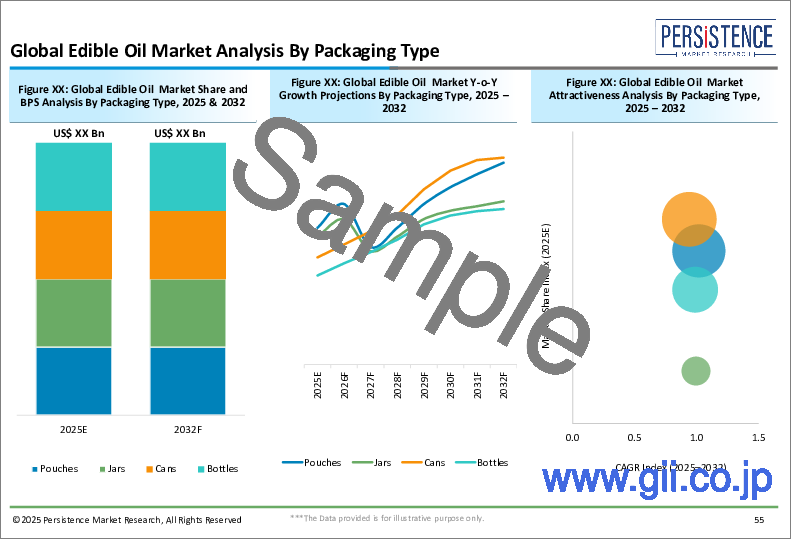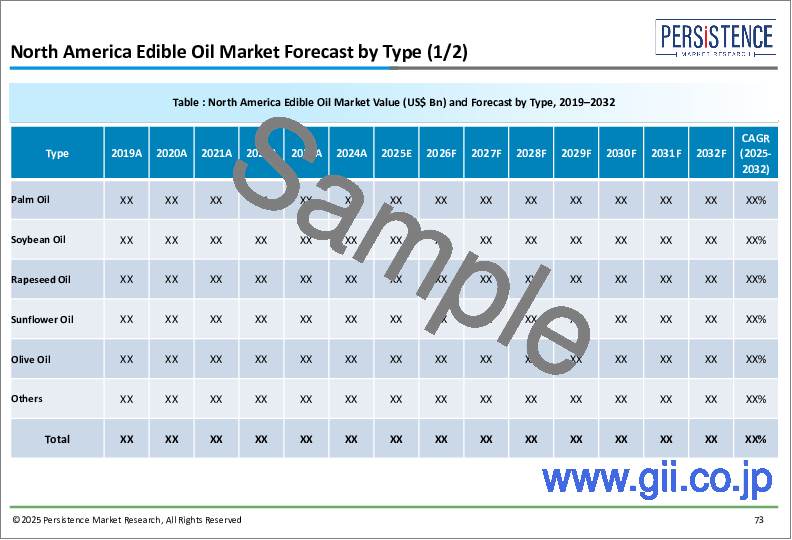|
|
市場調査レポート
商品コード
1672030
食用油の世界市場:産業分析、規模、シェア、成長、動向、予測(2025年~2032年)Edible Oils Market: Global Industry Analysis, Size, Share, Growth, Trends, and Forecast, 2025 - 2032 |
||||||
カスタマイズ可能
|
|||||||
| 食用油の世界市場:産業分析、規模、シェア、成長、動向、予測(2025年~2032年) |
|
出版日: 2025年03月04日
発行: Persistence Market Research
ページ情報: 英文 324 Pages
納期: 2~5営業日
|
全表示
- 概要
- 目次
重要考察
- 食用油の市場規模:2,226億米ドル(2025年)
- 予測される市場金額:3,217億米ドル(2032年)
- 世界市場の成長率:5.4%(2025年~2032年のCAGR)
食用油市場 - レポート範囲
食用油市場には、大豆油、パーム油、ひまわり油、オリーブ油、キャノーラ油など、幅広い植物性油が含まれます。これらの油は、調理、食品加工、さまざまな食品の生産に広く使用されています。市場は、家庭、フードサービス産業、食品製造など、多様なエンドユーザーに対応しています。この市場の成長の促進要因は、健康上の利点に対する消費者の意識の高まり、油加工技術の進歩、植物性食用油や強化食用油に対する需要の高まりです。
市場成長の促進要因
世界の食用油市場の主な促進要因は複数あります。世界人口の増加と可処分所得の増加により、各地域で食用油の消費が増加しています。消費者は、オリーブ油やアボカド油のような健康的な油の選択にシフトしています。さらに、油の精製と加工における技術の進歩により、油の品質が改善され、保存性と安定性が向上しています。持続可能な有機油に対する意識の高まりも、市場の成長を後押ししています。さらに、心臓にやさしくトランス脂肪酸を含まない油を推進する政府の取り組みも、市場情勢の拡大に寄与しています。
市場抑制要因
有望な成長見通しにもかかわらず、食用油市場は原材料価格の変動に関連する課題に直面しており、これが生産コストと価格設定全体に影響を及ぼしています。森林伐採や生息地の破壊など、パーム油栽培に関連する環境への懸念は、市場の拡大の障害となっています。さらに、油の精製と表示に関する厳しい規制が、メーカーに課題を突きつけています。バターやマーガリンといった代替油脂の入手可能性も、市場の需要に影響を与える可能性があります。こうした懸念に対処するには、持続可能な調達、規制遵守、製品革新への継続的な投資が必要です。
市場機会
市場は、有機、非遺伝子組み換え、栄養強化食用油に対する需要の増加により、大きな機会をもたらしています。ココナッツオイルやアボカドオイルなどの特殊油の人気が高まっていることも、市場の拡大の道を開いています。企業は、コールドプレス抽出などの革新的な加工技術を活用することで、栄養価を保持し、健康志向の消費者に対応することができます。eコマースや消費者直販チャネルの成長も新たな流通機会をもたらし、メーカーはより幅広い消費者層にリーチすることができます。戦略的パートナーシップ、持続可能な調達への投資、環境にやさしい包装の革新は、食用油部門の新たな動向を活用するために不可欠です。
当レポートでは、世界の食用油市場について調査分析し、成長促進要因、動向、機会、課題などの市場力学の詳細な分析を提供しています。
目次
第1章 エグゼクティブサマリー
第2章 市場の概要
- 市場の範囲/分類
- 市場の定義/範囲/制限
第3章 主な市場動向
- 市場に影響を与える主要動向
第4章 重要な成功要因
第5章 世界の市場規模と数量の分析
- 市場規模と数量の実績の分析(2019年~2024年)
- 現在と将来の市場数量の予測(2025年~2032年)
- 絶対的収益機会の分析
- 増分収益機会の分析
第6章 世界市場 - 価格分析
- 地域の価格分析:タイプ別
- 北米
- ラテンアメリカ
- 欧州
- 東アジア
- 南アジア・太平洋
- オセアニア
- 中東・アフリカ
第7章 市場の背景
- マクロ経済要因
- 世界の有機農地の見通し
- バリューチェーン分析
- 市場力学
- 予測要因 - 関連性と影響
第8章 世界市場の分析:タイプ別
- イントロダクション/主な調査結果
- 市場規模と数量の実績の分析:タイプ別(2019年~2024年)
- 現在と将来の市場規模と数量の分析と予測:タイプ別(2025年~2032年)
- パーム油
- 大豆油
- ひまわり油
- オリーブ油
- コーン油
- 菜種油
- その他
- 市場の魅力分析:タイプ別
第9章 世界市場の分析:性質別
- イントロダクション/主な調査結果
- 市場規模と数量の実績の分析:性質別(2019年~2024年)
- 現在と将来の市場規模と数量の分析と予測:性質別(2025年~2032年)
- 有機
- 従来式
- 市場の魅力分析:性質別
第10章 世界市場の分析:最終用途別
- イントロダクション/主な調査結果
- 市場規模と数量の実績の分析:最終用途別(2019年~2024年)
- 現在と将来の市場規模と数量の分析と予測:最終用途別(2025年~2032年)
- 産業
- フードサービス
- 小売
- 市場の魅力分析:最終用途別
第11章 世界市場の分析:流通チャネル別
- イントロダクション/主な調査結果
- 市場規模と数量の実績の分析:流通チャネル別(2019年~2024年)
- 現在と将来の市場規模と数量の分析と予測:流通チャネル別(2025年~2032年)
- B2B
- B2C
- 市場の魅力分析:流通チャネル別
第12章 世界市場の分析:地域別
- イントロダクション
- 市場規模と数量の実績の分析:地域別(2019年~2024年)
- 現在の市場規模と数量の分析と予測:地域別(2025年~2032年)
- 北米
- ラテンアメリカ
- 欧州
- 東アジア
- 南アジア・太平洋
- 中東・アフリカ
- 市場の魅力分析:地域別
第13章 北米市場の分析
第14章 ラテンアメリカ市場の分析
第15章 欧州市場の分析
第16章 南アジア・太平洋市場の分析
第17章 東アジア市場の分析
第18章 中東・アフリカ市場の分析
第19章 市場構造分析
第20章 競合分析
- 競合ダッシュボード
- 競合ベンチマーク
- 競合の詳細
- Cargill
- Archer Daniels Midland Company
- Fuji Vegetable Oil, Inc
- Bunge Limited
- Conagra Brands, Inc.
- Adani Group
- Marico
- Aveno NV
- The Adams Group Inc.
- American Vegetable Oils, Inc.
- COFCO
- The Nisshin OilliO Group, Ltd.
- Cereal Docks Spa
- Associated British Foods plc
- Borges International Group SL
- Emami Agrotech Ltd.
- Fytel Ltd
- Victoria Group
- Sunflower Vegetable Oil, Inc.
- Richardson International Limited
第21章 使用される前提条件と頭字語
第22章 調査手法
Persistence Market Research has recently published an extensive report on the global Edible Oils Market. This report offers a comprehensive analysis of the key market dynamics, including drivers, trends, opportunities, and challenges, providing deep insights into the market structure.
Key Insights:
- Edible Oils Market Size (2025E): USD 222.6 Bn
- Projected Market Value (2032F): USD 321.7 Bn
- Global Market Growth Rate (CAGR 2025 to 2032): 5.4%
Edible Oils Market - Report Scope:
The Edible Oils Market encompasses a wide range of vegetable-based oils, including soybean oil, palm oil, sunflower oil, olive oil, and canola oil, among others. These oils are widely used in cooking, food processing, and the production of various food products. The market caters to diverse end users, including households, foodservice providers, and the food manufacturing industry. Growth in this market is driven by increasing consumer awareness of health benefits, advancements in oil processing technology, and the rising demand for plant-based and fortified edible oils.
Market Growth Drivers:
Several key factors are driving the global Edible Oils Market. The rising global population and increasing disposable income are leading to higher consumption of edible oils across different regions. Consumers are shifting toward healthier oil options, such as olive and avocado oils, due to their beneficial nutritional profiles. Additionally, technological advancements in oil refining and processing have improved oil quality, ensuring better shelf life and stability. Growing awareness about sustainable and organic oils is also fueling market growth. Furthermore, government initiatives promoting heart-healthy and trans-fat-free oils contribute to expanding the market landscape.
Market Restraints:
Despite promising growth prospects, the Edible Oils Market faces challenges related to fluctuating raw material prices, which impact overall production costs and pricing. The environmental concerns associated with palm oil cultivation, including deforestation and habitat destruction, present hurdles for market expansion. Additionally, stringent regulations on oil refining and labeling pose challenges for manufacturers. The availability of alternative fats and oils, such as butter and margarine, can also impact market demand. Addressing these concerns requires continued investment in sustainable sourcing, regulatory compliance, and product innovation.
Market Opportunities:
The market presents significant opportunities driven by the increasing demand for organic, non-GMO, and fortified edible oils. The rising popularity of specialty oils, such as coconut oil and avocado oil, creates avenues for market expansion. Companies can leverage innovative processing techniques, such as cold-pressed extraction, to retain nutritional properties and cater to health-conscious consumers. The growth of e-commerce and direct-to-consumer channels also provides new distribution opportunities, enabling manufacturers to reach a wider consumer base. Strategic partnerships, investment in sustainable sourcing, and eco-friendly packaging innovations are essential to capitalizing on emerging trends in the edible oils sector.
Key Questions Answered in the Report:
- What are the primary factors driving the growth of the Edible Oils Market globally?
- Which types and sources of edible oils are leading the adoption in various settings?
- How are technological advancements influencing the competitive landscape of the Edible Oils Market?
- Who are the key players in the Edible Oils Market, and what strategies are they employing to stay competitive?
- What are the emerging trends and future prospects in the global Edible Oils Market?
Competitive Intelligence and Business Strategy:
Leading players in the global Edible Oils Market, including Cargill, Archer Daniels Midland Company, Wilmar International, and Bunge Limited, focus on product innovation, sustainable sourcing, and strategic partnerships to gain a competitive edge. These companies invest in research and development to introduce healthier and more sustainable edible oils. Collaborations with farmers and suppliers ensure a stable raw material supply while adhering to environmental standards. Extensive marketing strategies, consumer education campaigns, and innovative product offerings help strengthen brand loyalty and market position.
Key Companies Profiled:
- Cargill
- Archer Daniels Midland Company
- Fuji Vegetable Oil, Inc
- Bunge Limited
- Conagra Brands, Inc.
- Adani Group
- Marico
- Aveno NV
- The Adams Group Inc.
- American Vegetable Oils, Inc.
- COFCO
- The Nisshin OilliO Group, Ltd.
- Cereal Docks Spa
- Associated British Foods plc
- Borges International Group S.L.
- Emami Agrotech Ltd.
- Fytel Ltd
- Victoria Group
- Sunflower Vegetable Oil, Inc.
- Richardson International Limited
Edible Oils Market Industry Segmentation:
By Nature:
- Organic
- Conventional
By Type:
- Vegetable Oil
- Animal-based Oil
By Source:
- Palm Oil
- Soybean Oil
- Sunflower Oil
- Olive Oil
- Coconut Oil
- Canola Oil
- Others
By End Use:
- Food Processing Industry
- Foodservice
- Retail/Household
By Distribution Channel:
- Business to Business
- Business to Consumer
By Region:
- North America
- Latin America
- Europe
- South Asia & Pacific
- East Asia
- Middle East & Africa
Table of Contents
1. Executive Summary
- 1.1. Global Market Outlook
- 1.2. Demand Side Trends
- 1.3. Supply Side Trends
- 1.4. Analysis and Recommendations
2. Market Overview
- 2.1. Market Coverage / Taxonomy
- 2.2. Market Definition / Scope / Limitations
3. Key Market Trends
- 3.1. Key Trends Impacting the Market
4. Key Success Factors
5. Global Market Size (US$ Bn) and Volume (Tons) Analysis 2019-2024 and Forecast, 2025-2032
- 5.1. Historical Market Size and Volume Analysis, 2019-2024
- 5.2. Current and Future Market Volume Projections, 2025-2032
- 5.2.1. Absolute $ Opportunity Analysis
- 5.2.2. Incremental $ Opportunity Analysis
6. Global Market - Pricing Analysis
- 6.1. Regional Pricing Analysis By Type
- 6.1.1. North America
- 6.1.2. Latin America
- 6.1.3. Europe
- 6.1.4. East Asia
- 6.1.5. South Asia & Pacific
- 6.1.6. Oceania
- 6.1.7. Middle East and Africa (MEA)
7. Market Background
- 7.1. Macro-Economic Factors
- 7.1.1. Global GDP Growth Outlook
- 7.1.2. Global Urbanization Growth Outlook
- 7.1.3. Global Food Security Index
- 7.1.4. Final Consumption Expenditure
- 7.1.5. Global Rank - Ease of Doing Business
- 7.1.6. Global Rank - Trading Across Borders
- 7.2. Global Organic Agriculture Land Outlook
- 7.3. Value Chain Analysis
- 7.4. Market Dynamics
- 7.4.1. Drivers
- 7.4.2. Restraints
- 7.4.3. Opportunity Analysis
- 7.5. Forecast Factors - Relevance & Impact
8. Global Market Analysis 2019-2024 and Forecast 2025-2032, By Type
- 8.1. Introduction / Key Findings
- 8.2. Historical Market Size (US$ Bn) and Volume Analysis By Type, 2019-2024
- 8.3. Current and Future Market Size (US$ Bn) and Volume Analysis and Forecast By Type, 2025-2032
- 8.3.1. Palm Oil
- 8.3.2. Soybean Oil
- 8.3.3. Sunflower Oil
- 8.3.4. Olive Oil
- 8.3.5. Corn Oil
- 8.3.6. Rapeseeds Oil
- 8.3.7. Others
- 8.4. Market Attractiveness Analysis By Type
9. Global Market Analysis 2019-2024 and Forecast 2025-2032, By Nature
- 9.1. Introduction / Key Findings
- 9.2. Historical Market Size (US$ Bn) and Volume Analysis By Nature, 2019-2024
- 9.3. Current and Future Market Size (US$ Bn) and Volume Analysis and Forecast By Nature, 2025-2032
- 9.3.1. Organic
- 9.3.2. Conventional
- 9.4. Market Attractiveness Analysis By Nature
10. Global Market Analysis 2019-2024 and Forecast 2025-2032, By End-Use
- 10.1. Introduction / Key Findings
- 10.2. Historical Market Size (US$ Bn) and Volume Analysis By End-Use, 2019-2024
- 10.3. Current and Future Market Size (US$ Bn) and Volume Analysis and Forecast By End-Use, 2025-2032
- 10.3.1. Industrial
- 10.3.2. Food Service
- 10.3.3. Retail
- 10.4. Market Attractiveness Analysis By End-Use
11. Global Market Analysis 2019-2024 and Forecast 2025-2032, By Distribution Channel
- 11.1. Introduction / Key Findings
- 11.2. Historical Market Size (US$ Bn) and Volume Analysis By Distribution Channel, 2019-2024
- 11.3. Current and Future Market Size (US$ Bn) and Volume Analysis and Forecast By Distribution Channel, 2025-2032
- 11.3.1. Business to Business
- 11.3.2. Business to Consumer
- 11.3.2.1. Hypermarkets/Supermarkets
- 11.3.2.2. Speciality Stores
- 11.3.2.3. Convenience Stores
- 11.3.2.4. Online Retails
- 11.4. Market Attractiveness Analysis By Distribution Channel
12. Global Market Analysis 2019-2024 and Forecast 2025-2032, By Region
- 12.1. Introduction
- 12.2. Historical Market Size (US$ Bn) and Volume Analysis By Region, 2019-2024
- 12.3. Current Market Size (US$ Bn) and Volume Analysis and Forecast By Region, 2025-2032
- 12.3.1. North America
- 12.3.2. Latin America
- 12.3.3. Europe
- 12.3.4. East Asia
- 12.3.5. South Asia & Pacific
- 12.3.6. Middle East and Africa (MEA)
- 12.4. Market Attractiveness Analysis By Region
13. North America Market Analysis 2019-2024 and Forecast 2025-2032
- 13.1. Introduction
- 13.2. Historical Market Size (US$ Bn) and Volume Trend Analysis By Market Taxonomy, 2019-2024
- 13.3. Market Size (US$ Bn) and Volume Forecast By Market Taxonomy, 2025-2032
- 13.3.1. By Country
- 13.3.1.1. U.S.
- 13.3.1.2. Canada
- 13.3.2. By Type
- 13.3.3. By Nature
- 13.3.4. By End-Use
- 13.3.5. Distribution Channel
- 13.3.1. By Country
- 13.4. Market Attractiveness Analysis
- 13.4.1. By Country
- 13.4.2. By Type
- 13.4.3. By Nature
- 13.4.4. By End-Use
- 13.4.5. Distribution Channel
- 13.5. Drivers and Restraints - Impact Analysis
14. Latin America Market Analysis 2019-2024 and Forecast 2025-2032
- 14.1. Introduction
- 14.2. Historical Market Size (US$ Bn) and Volume Trend Analysis By Market Taxonomy, 2019-2024
- 14.3. Market Size (US$ Bn) and Volume Forecast By Market Taxonomy, 2025-2032
- 14.3.1. By Country
- 14.3.1.1. Brazil
- 14.3.1.2. Mexico
- 14.3.1.3. Argentina
- 14.3.1.4. Rest of Latin America
- 14.3.2. By Type
- 14.3.3. By Nature
- 14.3.4. By End-Use
- 14.3.5. Distribution Channel
- 14.3.1. By Country
- 14.4. Market Attractiveness Analysis
- 14.4.1. By Country
- 14.4.2. By Type
- 14.4.3. By Nature
- 14.4.4. By End-Use
- 14.4.5. Distribution Channel
- 14.5. Drivers and Restraints - Impact Analysis
15. Europe Market Analysis 2019-2024 and Forecast 2025-2032
- 15.1. Introduction
- 15.2. Historical Market Size (US$ Bn) and Volume Trend Analysis By Market Taxonomy, 2019-2024
- 15.3. Market Size (US$ Bn) and Volume Forecast By Market Taxonomy, 2025-2032
- 15.3.1. By Country
- 15.3.1.1. France
- 15.3.1.2. Germany
- 15.3.1.3. Spain
- 15.3.1.4. U.K.
- 15.3.1.5. Italy
- 15.3.1.6. BENELUX
- 15.3.1.7. Nordic
- 15.3.1.8. Russia
- 15.3.1.9. Poland
- 15.3.1.10. Rest of Europe
- 15.3.2. By Type
- 15.3.3. By Nature
- 15.3.4. By End-Use
- 15.3.5. Distribution Channel
- 15.3.1. By Country
- 15.4. Market Attractiveness Analysis
- 15.4.1. By Country
- 15.4.2. By Type
- 15.4.3. By Nature
- 15.4.4. By End-Use
- 15.4.5. Distribution Channel
- 15.5. Drivers and Restraints - Impact Analysis
16. South Asia & Pacific Market Analysis 2019-2024 and Forecast 2025-2032
- 16.1. Introduction
- 16.2. Historical Market Size (US$ Bn) and Volume Trend Analysis By Market Taxonomy, 2019-2024
- 16.3. Market Size (US$ Bn) and Volume Forecast By Market Taxonomy, 2025-2032
- 16.3.1. By Country
- 16.3.1.1. India
- 16.3.1.2. ASEAN
- 16.3.1.3. Oceania (Australia & New Zealand)
- 16.3.1.4. Rest of South Asia & Pacific
- 16.3.2. By Type
- 16.3.3. By Nature
- 16.3.4. By End-Use
- 16.3.5. Distribution Channel
- 16.3.1. By Country
- 16.4. Market Attractiveness Analysis
- 16.4.1. By Country
- 16.4.2. By Type
- 16.4.3. By Nature
- 16.4.4. By End-Use
- 16.4.5. Distribution Channel
- 16.5. Drivers and Restraints - Impact Analysis
17. East Asia Market Analysis 2019-2024 and Forecast 2025-2032
- 17.1. Introduction
- 17.2. Historical Market Size (US$ Bn) and Volume Trend Analysis By Market Taxonomy, 2019-2024
- 17.3. Market Size (US$ Bn) and Volume Forecast By Market Taxonomy, 2025-2032
- 17.3.1. By Country
- 17.3.1.1. Japan
- 17.3.1.2. China
- 17.3.1.3. South Korea
- 17.3.2. By Type
- 17.3.3. By Nature
- 17.3.4. By End-Use
- 17.3.5. Distribution Channel
- 17.3.1. By Country
- 17.4. Market Attractiveness Analysis
- 17.4.1. By Country
- 17.4.2. By Type
- 17.4.3. By Nature
- 17.4.4. By End-Use
- 17.4.5. Distribution Channel
- 17.5. Drivers and Restraints - Impact Analysis
18. Middle East and Africa Market Analysis 2019-2024 and Forecast 2025-2032
- 18.1. Introduction
- 18.2. Historical Market Size (US$ Bn) and Volume Trend Analysis By Market Taxonomy, 2019-2024
- 18.3. Market Size (US$ Bn) and Volume Forecast By Market Taxonomy, 2025-2032
- 18.3.1. By Country
- 18.3.1.1. GCC
- 18.3.1.2. Turkey
- 18.3.1.3. Nigeria
- 18.3.1.4. South Africa
- 18.3.1.5. Rest Of MEA
- 18.3.2. By Type
- 18.3.3. By Nature
- 18.3.4. By End-Use
- 18.3.5. Distribution Channel
- 18.3.1. By Country
- 18.4. Market Attractiveness Analysis
- 18.4.1. By Country
- 18.4.2. By Type
- 18.4.3. By Nature
- 18.4.4. By End-Use
- 18.4.5. Distribution Channel
- 18.5. Drivers and Restraints - Impact Analysis
19. Market Structure Analysis
20. Competition Analysis
- 20.1. Competition Dashboard
- 20.2. Competition Benchmarking
- 20.3. Competition Deep Dive
- 20.3.1. Cargill
- 20.3.1.1. Incorporated Overview
- 20.3.1.2. Product Portfolio
- 20.3.1.3. Key Developments/Key Takeaways
- 20.3.1.4. Strategy Overview
- 20.3.1.5. Financial Overview
- 20.3.2. Archer Daniels Midland Company
- 20.3.2.1. Incorporated Overview
- 20.3.2.2. Product Portfolio
- 20.3.2.3. Key Developments/Key Takeaways
- 20.3.2.4. Strategy Overview
- 20.3.2.5. Financial Overview
- 20.3.3. Fuji Vegetable Oil, Inc
- 20.3.3.1. Incorporated Overview
- 20.3.3.2. Product Portfolio
- 20.3.3.3. Key Developments/Key Takeaways
- 20.3.3.4. Strategy Overview
- 20.3.3.5. Financial Overview
- 20.3.4. Bunge Limited
- 20.3.4.1. Incorporated Overview
- 20.3.4.2. Product Portfolio
- 20.3.4.3. Key Developments/Key Takeaways
- 20.3.4.4. Strategy Overview
- 20.3.4.5. Financial Overview
- 20.3.5. Conagra Brands, Inc.
- 20.3.5.1. Incorporated Overview
- 20.3.5.2. Product Portfolio
- 20.3.5.3. Key Developments/Key Takeaways
- 20.3.5.4. Strategy Overview
- 20.3.5.5. Financial Overview
- 20.3.6. Adani Group
- 20.3.6.1. Incorporated Overview
- 20.3.6.2. Product Portfolio
- 20.3.6.3. Key Developments/Key Takeaways
- 20.3.6.4. Strategy Overview
- 20.3.6.5. Financial Overview
- 20.3.7. Marico
- 20.3.7.1. Incorporated Overview
- 20.3.7.2. Product Portfolio
- 20.3.7.3. Key Developments/Key Takeaways
- 20.3.7.4. Strategy Overview
- 20.3.7.5. Financial Overview
- 20.3.8. Aveno NV
- 20.3.8.1. Incorporated Overview
- 20.3.8.2. Product Portfolio
- 20.3.8.3. Key Developments/Key Takeaways
- 20.3.8.4. Strategy Overview
- 20.3.8.5. Financial Overview
- 20.3.9. The Adams Group Inc.
- 20.3.9.1. Incorporated Overview
- 20.3.9.2. Product Portfolio
- 20.3.9.3. Key Developments/Key Takeaways
- 20.3.9.4. Strategy Overview
- 20.3.9.5. Financial Overview
- 20.3.10. American Vegetable Oils, Inc.
- 20.3.10.1. Incorporated Overview
- 20.3.10.2. Product Portfolio
- 20.3.10.3. Key Developments/Key Takeaways
- 20.3.10.4. Strategy Overview
- 20.3.10.5. Financial Overview
- 20.3.11. COFCO
- 20.3.11.1. Incorporated Overview
- 20.3.11.2. Product Portfolio
- 20.3.11.3. Key Developments/Key Takeaways
- 20.3.11.4. Strategy Overview
- 20.3.11.5. Financial Overview
- 20.3.12. The Nisshin OilliO Group, Ltd.
- 20.3.12.1. Incorporated Overview
- 20.3.12.2. Product Portfolio
- 20.3.12.3. Key Developments/Key Takeaways
- 20.3.12.4. Strategy Overview
- 20.3.12.5. Financial Overview
- 20.3.13. Cereal Docks Spa
- 20.3.13.1. Incorporated Overview
- 20.3.13.2. Product Portfolio
- 20.3.13.3. Key Developments/Key Takeaways
- 20.3.13.4. Strategy Overview
- 20.3.13.5. Financial Overview
- 20.3.14. Associated British Foods plc
- 20.3.14.1. Incorporated Overview
- 20.3.14.2. Product Portfolio
- 20.3.14.3. Key Developments/Key Takeaways
- 20.3.14.4. Strategy Overview
- 20.3.14.5. Financial Overview
- 20.3.15. Borges International Group S.L.
- 20.3.15.1. Incorporated Overview
- 20.3.15.2. Product Portfolio
- 20.3.15.3. Key Developments/Key Takeaways
- 20.3.15.4. Strategy Overview
- 20.3.15.5. Financial Overview
- 20.3.16. Emami Agrotech Ltd.
- 20.3.16.1. Incorporated Overview
- 20.3.16.2. Product Portfolio
- 20.3.16.3. Key Developments/Key Takeaways
- 20.3.16.4. Strategy Overview
- 20.3.16.5. Financial Overview
- 20.3.17. Fytel Ltd
- 20.3.17.1. Incorporated Overview
- 20.3.17.2. Product Portfolio
- 20.3.17.3. Key Developments/Key Takeaways
- 20.3.17.4. Strategy Overview
- 20.3.17.5. Financial Overview
- 20.3.18. Victoria Group
- 20.3.18.1. Incorporated Overview
- 20.3.18.2. Product Portfolio
- 20.3.18.3. Key Developments/Key Takeaways
- 20.3.18.4. Strategy Overview
- 20.3.18.5. Financial Overview
- 20.3.19. Sunflower Vegetable Oil, Inc.
- 20.3.19.1. Incorporated Overview
- 20.3.19.2. Product Portfolio
- 20.3.19.3. Key Developments/Key Takeaways
- 20.3.19.4. Strategy Overview
- 20.3.19.5. Financial Overview
- 20.3.20. Richardson International Limited
- 20.3.20.1. Incorporated Overview
- 20.3.20.2. Product Portfolio
- 20.3.20.3. Key Developments/Key Takeaways
- 20.3.20.4. Strategy Overview
- 20.3.20.5. Financial Overview
- 20.3.1. Cargill





